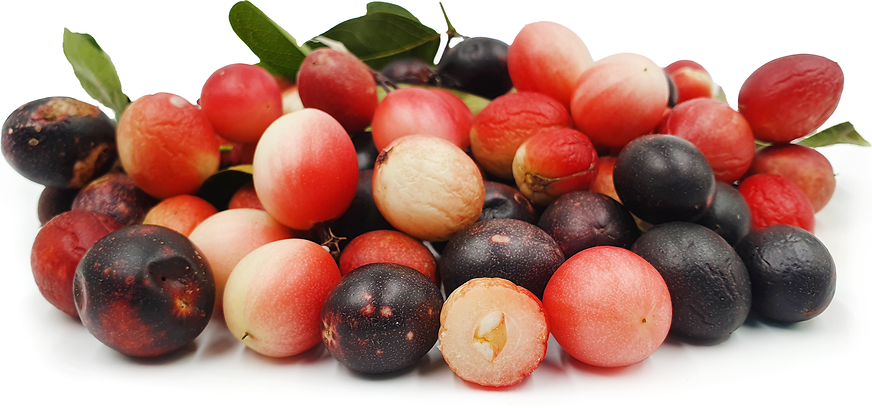


Karonda Fruit
Estimated Inventory, lb : 0
Description/Taste
Karonda fruits are small berries, averaging 1 to 3 centimeters in length, and have an oval to ovoid shape with curved ends. The berries grow in clusters of 3 to 10 fruits and ripen at different stages, giving the shrub a multi-colored appearance. When young, the fruits are green to white, transitioning into a bright red-pink hue, finally ripening into a dark purple, almost black shade with maturity. The thin but tough skin will also change from taut, smooth, and glossy to slightly wrinkled with some give when ripe. Underneath the surface, the flesh ranges from pale red to crimson, depending on the degree of ripeness, and is aqueous and soft, encasing 2 to 8 flat, brown seeds. When harvested, the fruits may also emit a milky white latex that should be removed before eating. Karonda fruits have a subtly sweet, herbal taste with prominent sour, bitter, tart, and acidic notes. Each berry will vary in flavor depending on the growing environment and maturity.
Seasons/Availability
Karonda fruits are available in the summer through early fall.
Current Facts
Karonda fruits, botanically classified as Carissa carandas, are sour, subtly sweet berries growing on a woody shrub belonging to the Apocynaceae family. The ancient species is naturalized in tropical and subtropical regions throughout Africa, Asia, and Southeast Asia and is primarily used as a living fence, medicinal ingredient, and edible food source. The plants also range in availability, with some regions of Malaysia considering Karonda fruits to be rare, while other areas of India and Africa regard the plant to be abundant. Karonda fruits are known by many regional names, including Kerenda or Karanda in Malaysia, Kerendang, Buah Renda, and Samarinda fruit in Indonesia, Namdaeng and Nam Phrom in Thailand, and as Karanda, Kerenda, the Bengal Currant, and Caranda fruit. Karonda fruits are not cultivated commercially and are foraged from wild and garden plants for sale in local markets.
Nutritional Value
Karonda fruits are an excellent source of iron to help transport oxygen within the blood and vitamin C to strengthen the immune system, boost collagen production, and reduce inflammation. The fruits also provide phosphorus, vitamin A, and calcium. In traditional medicines of Asia and Africa, Karonda fruits are utilized for their anti-inflammatory properties and are believed to help with indigestion, colds and flu, and anemia.
Applications
Karonda fruits are best suited for cooked applications as their sour flavor is neutralized when combined with sweeteners. The fruits can be eaten raw, but some berries may have a very tart, almost unpalatable flavor. In Thailand, fresh fruits are consumed with sugar, salt, or chile powder to balance the sour flavors. The fruits are also soaked in salted water to help remove the latex sap and reduce the bitter notes found within the skin. When pressed, Karonda fruits exude a bright red juice, creating an attractive coloring for beverages, smoothies, and cocktails. The juice can also be cooked into a syrup and incorporated into sodas, carbonated waters, and fruit punches. In addition to juices, Karonda fruits are cooked into jellies and jams or used as a filling for baked goods such as tarts and pies. The fruits can also be stirred into savory dishes, including curries, and are pickled when young and eaten as a condiment. Karonda fruits pair well with vanilla, spices such as turmeric, curry powder, cloves, chile powder, and mustard seed, and aromatics such as onions, ginger, and garlic. Whole, ripe Karonda fruits will keep 3 to 4 days in the refrigerator. The fruits will begin to shrivel as they decline in freshness.
Ethnic/Cultural Info
Karonda fruits were spread across India in the 19th century when they were incorporated into a living fence known as The Great Hedge of India. The barrier was constructed by the British Empire to prohibit the illegal trade of salt throughout the country. It took over 30 years to finish The Great Hedge, and thorny shrubs, including Karonda, were planted along the Inland Customs Line, which was a border established by the British to implement taxes on salt to regions of India that did not have the flavoring readily available. Karonda shrubs can grow up to four meters in height and form dense thickets of thorny branches, creating an impenetrable, natural wall. The shrubs were also intermixed with dead branches and other species of prickly bushes to create a barrier that could not be easily destroyed. Despite the toiling efforts to construct The Great Hedge, the wall was eventually demolished as the British Empire fell, and little remains of the fence in the modern-day. The empty land once inhabited by the wall was turned into a series of roads, but some Karonda shrubs can still be seen alongside these roads as a subtle reminder of the fence that once stood.
Geography/History
Karonda fruits are native to Asia, widely found in India and Nepal, and the flowering shrubs have been growing wild for thousands of years. The shrubs were spread across Asia in ancient times to Southeast Asia, mainly Malaysia and Indonesia, and continued to become naturalized in tropical regions of Australia and Africa. In 1912, Karonda fruits were transported from the Middle Egypt Botanic Garden to the United States, where the shrubs were planted in test regions of California and Florida. The fruits were also introduced to the Philippines in 1915. Today Karonda fruits are primarily foraged from naturalized shrubs and are found in local markets in regions of India, Nepal, Bangladesh, Sri Lanka, Afghanistan, East Africa, Thailand, Vietnam, Cambodia, Malaysia, Indonesia, the Philippines, Australia, and the United States.
Recipe Ideas
Recipes that include Karonda Fruit. One
| Times of India |
|
Karonda Jam |
| Foodeez Junction |
|
Karonda Sabzi |
| Something's Cooking With Alpa |
|
Pickled Karonda |
| Cook Safari |
|
Karonda Mirch Ki Sabzi |
| Food Fond |
|
Karonda Curry |




